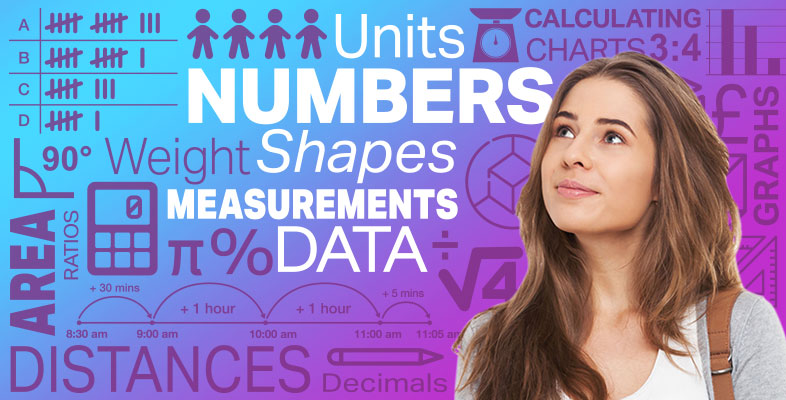6.4 Finding the mean from a frequency table
Large groups of data will often be shown as a frequency table, rather than as a long list. This is a much more user friendly way to look at a large set of data. Look at the example below where there is data on how many times, over a year, customers used a gardening service.
| Number of visits in a year | Number of customers |
|---|---|
| 1 | 6 |
| 2 | 10 |
| 3 | 11 |
| 4 | 16 |
| 5 | 4 |
| 6 | 3 |
We could write this as a list if we wanted to:
1, 1, 1, 1, 1, 1, 2, 2, 2, 2, 2, 2, 2, 2, 2, 2, 3, 3, 3, 3, 3, 3, 3, 3, 3, 3, 3 and so on
but it’s much clearer to look at in the table format. But how would you find the mean of this data? Well, there were 6 customers who had one visit from the gardening company, that’s a total of 1 × 6 = 6 visits. Then there were 10 customers who had 2 visits, that’s a total of 2 × 10 = 20 visits. Do this for each row of the table, as shown below.
| Number of visits in a year | Number of customers | Total visits |
|---|---|---|
| 1 | 6 | 1 × 6 = 6 |
| 2 | 10 | 2 × 10 = 20 |
| 3 | 11 | 3 × 11 = 33 |
| 4 | 16 | 4 × 16 = 64 |
| 5 | 4 | 5 × 4 = 20 |
| 6 | 3 | 6 × 3 = 18 |
| HighlightedTotal = 50 customers | HighlightedTotal = 161 visits |
Finally, work out the totals for each column (highlighted in a lighter colour on the table above).
Now you have all the information you need to find the mean; the total number of visits is 161 and the total number of customers is 50 so you do 161 ÷ 50 = 3.22 visits per year as the mean average.
Warning! Many people trip up on these because they will find the total visits (161) but rather than divide by the total number of customers (50) they divide by the number of rows in the table (in this example, 6).
If you do 161 ÷ 6 = 26.83, logic tells you, that since the maximum number of visits any customer had was 6, the mean average cannot be 26.83. Always sense check your answer to make sure it is somewhere between the lowest and highest values of the table. For this example, anything below 1 or above 6 must be incorrect!
Have a go at a couple of these yourself so that you feel confident with this skill.
Activity _unit4.6.3 Activity 11: Finding the mean from frequency tables
The table below shows some data about the number of times children were absent from school over a term.
Work out the mean average number of absences.
| Number of absences | Number of children |
|---|---|
| 1 | 26 |
| 2 | 13 |
| 3 | 0 |
| 4 | 35 |
| 5 | 6 |
Answer
First, work out the total number of absences by multiplying the absence column by the number of children. Next, work out the totals for each column.
| Number of absences | Number of children | Total number of absences |
|---|---|---|
| 1 | 26 | 1 × 26 = 26 |
| 2 | 13 | 2 × 13 = 26 |
| 3 | 0 | 3 × 0 = 0 |
| 4 | 35 | 4 × 35 = 140 |
| 5 | 6 | 5 × 6 = 30 |
| HighlightedTotal = 80 | HighlightedTotal = 222 |
To find the mean do: 222 ÷ 80 = 2.775 mean average.
You run a youth club for 16–21-year-olds and are interested in the average age of young people who attend.
You collect the information shown in the table below. Work out the mean age of those who attend. Give your answer rounded to one decimal place.
| Age | Number of young people |
|---|---|
| 16 | 3 |
| 17 | 8 |
| 18 | 5 |
| 19 | 12 |
| 20 | 6 |
| 21 | 1 |
Answer
Again, first work out the totals for each row and column.
| Age | Number of young people | Age × Number |
|---|---|---|
| 16 | 3 | 16 × 3 = 48 |
| 17 | 8 | 17 × 8 = 136 |
| 18 | 5 | 18 × 5 = 90 |
| 19 | 12 | 19 × 12 = 228 |
| 20 | 6 | 20 × 6 = 120 |
| 21 | 1 | 21 × 1 = 21 |
| HighlightedTotal = 35 | HighlightedTotal = 643 |
To find the mean you then do:
643 ÷ 35 = 18.4 years (rounded to one d.p.)
If you are given all the data in a set and asked to find the mean, it’s a relatively simple process (as long as you have your calculator handy!). What if you are only given some of the data and the mean? How do you go about working out the missing data? The next part of this section deals with these kind of ‘reverse mean’ skills.
